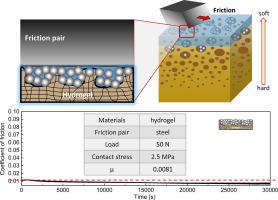Our official English website, www.x-mol.net, welcomes your
feedback! (Note: you will need to create a separate account there.)
Converting “sliding” to “rolling” design for high-performance lubricating hydrogel
Giant ( IF 5.4 ) Pub Date : 2024-05-29 , DOI: 10.1016/j.giant.2024.100296 Fangbin Fan , Jinrui Han , Li Zhao , Bo Yu , Meirong Cai , Xiaowei Pei , Zhizhi Zhang , Shuanhong Ma , Yanfei Ma , Feng Zhou
Giant ( IF 5.4 ) Pub Date : 2024-05-29 , DOI: 10.1016/j.giant.2024.100296 Fangbin Fan , Jinrui Han , Li Zhao , Bo Yu , Meirong Cai , Xiaowei Pei , Zhizhi Zhang , Shuanhong Ma , Yanfei Ma , Feng Zhou

|
Despite the excellent lubricity of conventional hydrogel materials due to their wet-soft properties, they produce severe mechanical elastic deformation at higher interfacial contact stresses. Balancing the load-bearing capacity and lubricating properties of hydrogel material is the difficulty of the current research work for articular cartilage substitutes. Great progress has been made in developing bionic joint materials with high load-bearing and low-friction hydrogels based on gradient designs. However, most bionic materials are based on sliding friction greatly limiting the improvement of lubrication performance. Herein, we designed and prepared a new hydrogel material with high load-bearing capacity and stable lubrication performance, breaking through the traditional friction method and turning to “sliding” for “rolling”. The network on the hydrogel surface was dissociated by UV irradiation and the pores on the surface were filled with SiO nanoparticles. The dense network structure of the underlying layer endows the hydrogel material with good load-bearing properties, while the high degree of hydration of the surface layer and the rolling friction effect of SiO nanoparticles greatly enhance the lubrication property. With the synergistic effect of these designs, the multi-layered hydrogel with nanoparticles on the surface achieved an ultra-low average coefficient of friction (COF) of ∼0.00809 at a high load of 50 N during 30,000 cycles. This idea of hydrogel material design provides a new strategy for the replacement of biomimetic articular cartilage materials.
中文翻译:

将“滑动”设计转变为“滚动”设计,实现高性能润滑水凝胶
尽管传统水凝胶材料由于其湿软特性而具有优异的润滑性,但它们在较高的界面接触应力下会产生严重的机械弹性变形。平衡水凝胶材料的承载能力和润滑性能是目前关节软骨替代品研究工作的难点。基于梯度设计的高承载、低摩擦水凝胶仿生关节材料的开发取得了巨大进展。然而,大多数仿生材料都是基于滑动摩擦,极大地限制了润滑性能的提高。在此,我们设计并制备了一种具有高承载能力和稳定润滑性能的新型水凝胶材料,突破了传统的摩擦方式,由“滚动”转向“滑动”。水凝胶表面的网络在紫外线照射下解离,表面的孔隙被SiO纳米颗粒填充。底层致密的网络结构赋予水凝胶材料良好的承载性能,而表层的高度水化和SiO纳米粒子的滚动摩擦效应大大增强了润滑性能。通过这些设计的协同效应,表面具有纳米颗粒的多层水凝胶在 30,000 次循环中在 50 N 的高负载下实现了~0.00809 的超低平均摩擦系数(COF)。这种水凝胶材料的设计思路为仿生关节软骨材料的替代提供了新的策略。
更新日期:2024-05-29
中文翻译:

将“滑动”设计转变为“滚动”设计,实现高性能润滑水凝胶
尽管传统水凝胶材料由于其湿软特性而具有优异的润滑性,但它们在较高的界面接触应力下会产生严重的机械弹性变形。平衡水凝胶材料的承载能力和润滑性能是目前关节软骨替代品研究工作的难点。基于梯度设计的高承载、低摩擦水凝胶仿生关节材料的开发取得了巨大进展。然而,大多数仿生材料都是基于滑动摩擦,极大地限制了润滑性能的提高。在此,我们设计并制备了一种具有高承载能力和稳定润滑性能的新型水凝胶材料,突破了传统的摩擦方式,由“滚动”转向“滑动”。水凝胶表面的网络在紫外线照射下解离,表面的孔隙被SiO纳米颗粒填充。底层致密的网络结构赋予水凝胶材料良好的承载性能,而表层的高度水化和SiO纳米粒子的滚动摩擦效应大大增强了润滑性能。通过这些设计的协同效应,表面具有纳米颗粒的多层水凝胶在 30,000 次循环中在 50 N 的高负载下实现了~0.00809 的超低平均摩擦系数(COF)。这种水凝胶材料的设计思路为仿生关节软骨材料的替代提供了新的策略。


















































 京公网安备 11010802027423号
京公网安备 11010802027423号